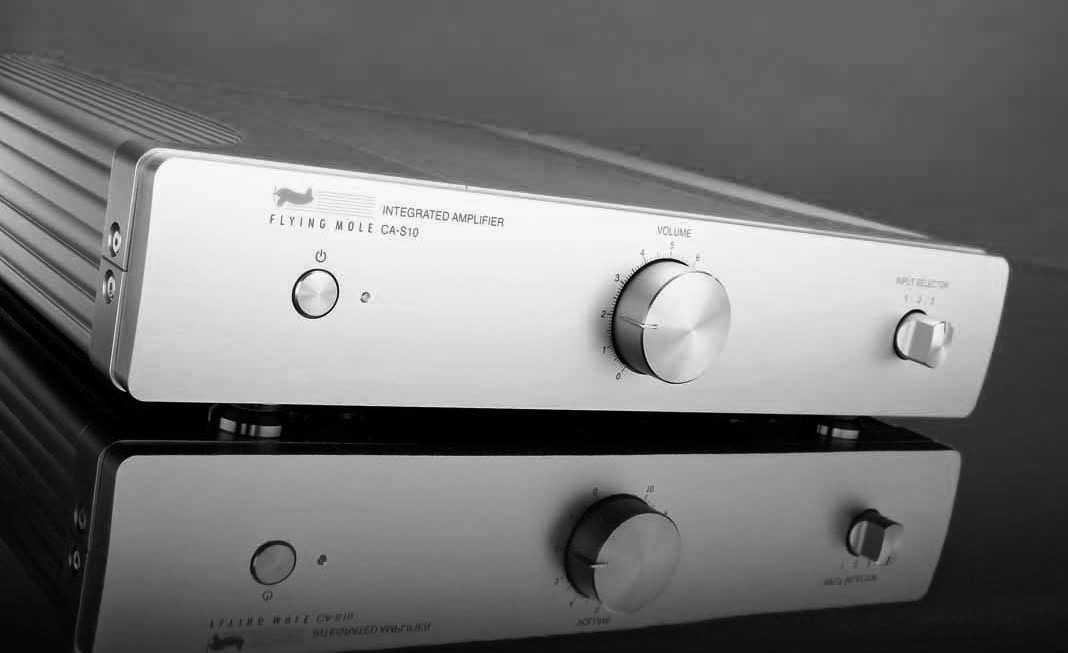While
this is a 100-watt
amplifier, it doesn't have
the energy that one
associates with that sort of
power rating, and it
couldn't comfortably drive
our big B&W 802D
loudspeakers. This is not
the first time they have
made the life of an
‘affordable' amplifier
difficult, and given the
price differential it's an
unlikely real-world
partnership. However, the
pairing did stay together
long enough to reveal the
extraordinary levels of
detail that the amp can
produce. It achieves this as
a result of having an
uncannily clean sound, which
makes alternatives sound
electronic or mechanical by
comparison. On the other
hand, there is a slight
fragility to the CA-S10's
sound that discourages
headbanging and leads your
listening towards higher
cultural ground. It will
play loud with a suitably
sensitive pair of speakers,
but is devoid of the punch
and vibrancy of a top-notch
Class AB amplifier.

Click to enlarge |
This is either because it
doesn't have certain
euphonic distortions that
create the sensation of
energy, which is presumably
a result of the
characteristics of regular
power supplies and output
devices combined, or because
it is intrinsically less
muscular and less able to
drive real-world speaker
loads. Digital amps of yore
have suffered from a far
higher sensitivity to the
load they are driving than
their analogue counterparts,
which can result in a sound
that seems to lack dynamics.
Given that early stumble
when fighting above its
weight with the B&W, we
lined up a variety of
different speakers to see
how well this aeronautical
lawn-breaker coped.
In
the main, it handled things
very well. The Mole was
unfazed by Acoustic Energy's
AE1, a compact, metal-driver
speaker that's designed to
take a lot of power. The amp
extracted a solid and tight
bass allied to a
super-detailed midband and a
well extended and remarkably
clean top end, one which
revelled in finer,
high-resolution recordings
such as David Wilczewski's
Room in the Clouds
SACD. Similarly, the more
analytical qualities of
ATC's SCM19 standmount did
little to undermine the
Mole's case. Here, the amp
allowed the speaker to
reveal decent tonal variety
from a male choir and a
thoroughly engaging sense of
timing. It also did a good
job of distracting from the
analysis and letting us hear
the music.
Even the aforementioned
802D, while being too much
of a handful for the amp to
sound like it was in full
control, illustrated how the
quality of high-frequency
resolve provides definition
right across the audio band.
The bass got a little boomy
and lacked the conviction
and gravitas that more
powerful sounding amplifiers
can extract from this
speaker, yet the Mole did

Click to enlarge |
show
the shape of higher bass
notes well and managed to
provide plenty of timing
clues.
The
Flying
Mole
design reveals what can be
achieved with digital amp
technology if you leave out
the bells and whistles and
focus on the essence. This
is a remarkably refined
performer, even in the face
of some seriously good
recent amplifiers in and
around the same price. The
only real limitation is in
the dynamic range, and even
here this is a relatively
mild shortcoming. This is
not an amplifier that plays
loud, but neither does it
‘sound' loud at any given
volume level. Normally,
perceptibly loud
amplification suggests
distortion, but the CA-S10
understates the sound more
than usual. Other
low-distortion amplifiers
seem louder because they
pull out dynamics
significantly better, which
suggests greater sensitivity
to level variations. Such
designs are rare, but not
impossible to find at the
Flying
Mole's
price.
So
it's a matter of picking
your compromise – there's
usually an alternative that
does something a little
better. But here it's pretty
fundamental: do you want a
refined and incredibly clean
sound that demands a smooth,
high-quality source, or do
you want a ballsy sound with
grunt that is better suited
to rocking out? If you think
that the former could be for
you, then this small but
beautifully-formed amp is a
hard act to beat. So long as
you don't want the bells and
whistles, of course.
___________________________________
Flying
Mole
CA-S10
¦
$2499 ¦



 ¦
¦
For:
Extraordinary clean and
revealing sound that brings
a new level of refinement
Verdict:
Features are basic, but for
the purist this Mole
delivers a mountain of
detailed sound
